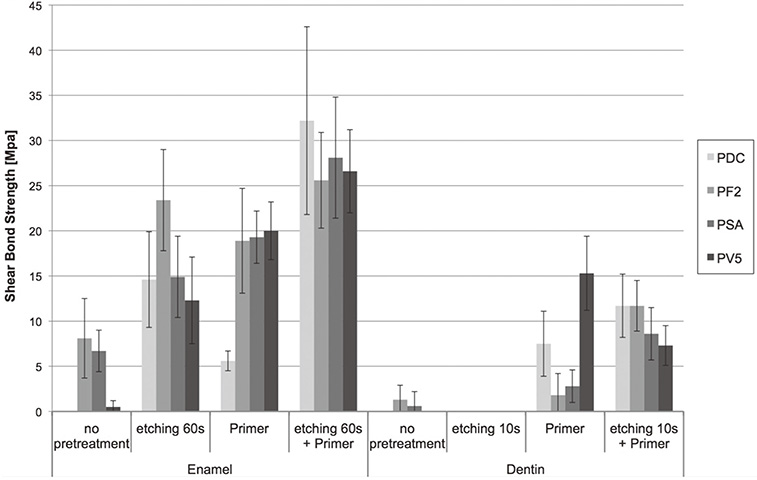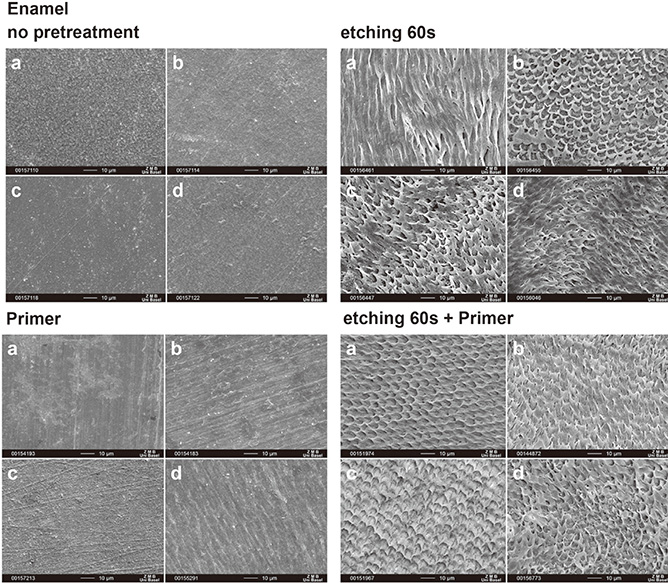J Adv Prosthodont.
2017 Apr;9(2):85-92. 10.4047/jap.2017.9.2.85.
Tooth surface treatment strategies for adhesive cementation
- Affiliations
-
- 1Division of Dental Materials and Engineering, Department of Reconstructive Dentistry and Temporomandibular Disorders, University Center for Dental Medicine, University of Basel, Switzerland. nadja.rohr@unibas.ch
- KMID: 2376294
- DOI: http://doi.org/10.4047/jap.2017.9.2.85
Abstract
- PURPOSE
The aim of this study was to evaluate the effect of tooth surface pre-treatment steps on shear bond strength, which is essential for understanding the adhesive cementation process.
MATERIALS AND METHODS
Shear bond strengths of different cements with various tooth surface treatments (none, etching, priming, or etching and priming) on enamel and dentin of human teeth were measured using the Swiss shear test design. Three adhesives (Permaflo DC, Panavia F 2.0, and Panavia V5) and one self-adhesive cement (Panavia SA plus) were included in this study. The interface of the cement and the tooth surface with the different pre-treatments was analyzed using SEM. pH values of the cements and primers were measured.
RESULTS
The highest bond strength values for all cements were achieved with etching and primer on enamel (25.6 ± 5.3 - 32.3 ± 10.4 MPa). On dentin, etching and priming produced the highest bond strength values for all cements (8.6 ± 2.9 - 11.7 ± 3.5 MPa) except for Panavia V5, which achieved significantly higher bond strengths when pre-treated with primer only (15.3 ± 4.1 MPa). Shear bond strength values were correlated with the micro-retentive surface topography of enamel and the tag length on dentin except for Panavia V5, which revealed the highest bond strength with primer application only without etching, resulting in short but sturdy tags.
CONCLUSION
The highest bond strength can be achieved for Panavia F 2.0, Permaflo DC, and Panavia SA plus when the tooth substrate is previously etched and the respective primer is applied. The new cement Panavia V5 displayed low technique-sensitivity and attained significantly higher adhesion of all tested cements to dentin when only primer was applied.
Keyword
MeSH Terms
Figure
Reference
-
1. Edelhoff D, Ozcan M. To what extent does the longevity of fixed dental prostheses depend on the function of the cement? Working Group 4 materials: cementation. Clin Oral Implants Res. 2007; 18:193–204.2. Federlin M, Sipos C, Hiller KA, Thonemann B, Schmalz G. Partial ceramic crowns. Influence of preparation design and luting material on margin integrity-a scanning electron microscopic study. Clin Oral Investig. 2005; 9:8–17.3. Van Meerbeek B, De Munck J, Yoshida Y, Inoue S, Vargas M, Vijay P, Van Landuyt K, Lambrechts P, Vanherle G. Buonocore memorial lecture. Adhesion to enamel and dentin: current status and future challenges. Oper Dent. 2003; 28:215–235.4. Salvio LA, Hipólito VD, Martins AL, de Goes MF. Hybridization quality and bond strength of adhesive systems according to interaction with dentin. Eur J Dent. 2013; 7:315–326.5. Monticelli F, Osorio R, Mazzitelli C, Ferrari M, Toledano M. Limited decalcification/diffusion of self-adhesive cements into dentin. J Dent Res. 2008; 87:974–979.6. Al-Assaf K, Chakmakchi M, Palaghias G, Karanika-Kouma A, Eliades G. Interfacial characteristics of adhesive luting resins and composites with dentine. Dent Mater. 2007; 23:829–839.7. Radovic I, Monticelli F, Goracci C, Vulicevic ZR, Ferrari M. Self-adhesive resin cements: a literature review. J Adhes Dent. 2008; 10:251–258.8. Stape TH, Menezes Mde S, Barreto Bde C, Naves LZ, Aguiar FH, Quagliatto PS, Martins LR. Influence of chlorhexidine on dentin adhesive interface micromorphology and nanoleakage expression of resin cements. Microsc Res Tech. 2013; 76:788–794.9. Yoshida Y, Nagakane K, Fukuda R, Nakayama Y, Okazaki M, Shintani H, Inoue S, Tagawa Y, Suzuki K, De Munck J, Van Meerbeek B. Comparative study on adhesive performance of functional monomers. J Dent Res. 2004; 83:454–458.10. De Munck J, Van Landuyt K, Peumans M, Poitevin A, Lambrechts P, Braem M, Van Meerbeek B. A critical review of the durability of adhesion to tooth tissue: methods and results. J Dent Res. 2005; 84:118–132.11. Turp V, Sen D, Tuncelli B, Ozcan M. Adhesion of 10-MDP containing resin cements to dentin with and without the etchand-rinse technique. J Adv Prosthodont. 2013; 5:226–233.12. Van Noort R, Noroozi S, Howard IC, Cardew G. A critique of bond strength measurements. J Dent. 1989; 17:61–67.13. Holderegger C, Sailer I, Schuhmacher C, Schläpfer R, Hämmerle C, Fischer J. Shear bond strength of resin cements to human dentin. Dent Mater. 2008; 24:944–950.14. Stawarczyk B, Hartmann R, Hartmann L, Roos M, Ozcan M, Sailer I, Hämmerle CH. The effect of dentin desensitizer on shear bond strength of conventional and self-adhesive resin luting cements after aging. Oper Dent. 2011; 36:492–501.15. Bähr N, Keul C, Edelhoff D, Eichberger M, Roos M, Gernet W, Stawarczyk B. Effect of different adhesives combined with two resin composite cements on shear bond strength to polymeric CAD/CAM materials. Dent Mater J. 2013; 32:492–501.16. Lopes GC, Thys DG, Klaus P, Oliveira GM, Widmer N. Enamel acid etching: a review. Compend Contin Educ Dent. 2007; 28:18–24.17. Swift EJ Jr, Perdigão J, Heymann HO, Ritter AV. Shear bond strengths of one-bottle adhesives to moist enamel. J Esthet Dent. 1999; 11:103–107.18. Federlin M, Hiller KA, Schmalz G. Effect of selective enamel etching on clinical performance of CAD/CAM partial ceramic crowns luted with a self-adhesive resin cement. Clin Oral Investig. 2014; 18:1975–1984.19. Baader K, Hiller KA, Buchalla W, Schmalz G, Federlin M. Self-adhesive luting of partial ceramic crowns: Selective enamel etching leads to higher survival after 6.5 years in vivo. J Adhes Dent. 2016; 18:69–79.20. Jacobsen T, Söderholm KJ. Some effects of water on dentin bonding. Dent Mater. 1995; 11:132–136.21. Vogl V, Hiller KA, Buchalla W, Federlin M, Schmalz G. Controlled, prospective, randomized, clinical split-mouth evaluation of partial ceramic crowns luted with a new, universal adhesive system/resin cement: results after 18 months. Clin Oral Investig. 2016; 20:2481–2492.
- Full Text Links
- Actions
-
Cited
- CITED
-
- Close
- Share
- Similar articles
-
- Influence of different surface treatments on bond strength of novel CAD/CAM restorative materials to resin cement
- THE RETRIEVABILITY OF CEMENTATION TYPE IMPLANT ABUTMENT BY SURFACE TREATMENTS AND TYPES OF CEMENTS
- Comparison of adhesive strength of resinous teeth splinting materials according to enamel surface treatment
- 'Wet or Dry tooth surface?' - for self-adhesive resin cement
- Effect of different adhesive systems and post surface treatments on the push-out bond strengths of fiber-reinforced post




